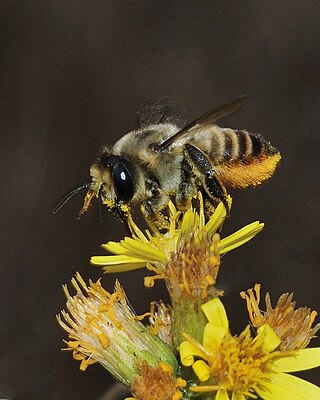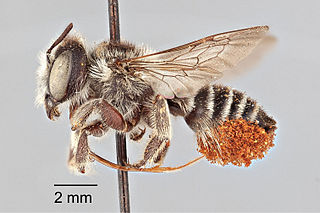
In polymer chemistry and materials science, a resin is a solid or highly viscous substance of plant or synthetic origin that is typically convertible into polymers. Resins are usually mixtures of organic compounds. This article focuses mainly on naturally occurring resins.

Megachilidae is a cosmopolitan family of mostly solitary bees. Characteristic traits of this family are the restriction of their pollen-carrying structure to the ventral surface of the abdomen, and their typically elongated labrum. Megachilid genera are most commonly known as mason bees and leafcutter bees, reflecting the materials from which they build their nest cells ; a few collect plant or animal hairs and fibers, and are called carder bees, while others use plant resins in nest construction and are correspondingly called resin bees. All species feed on nectar and pollen, but a few are kleptoparasites, feeding on pollen collected by other megachilid bees. Parasitic species do not possess scopae. The motion of Megachilidae in the reproductive structures of flowers is energetic and swimming-like; this agitation releases large amounts of pollen.

The genus Megachile is a cosmopolitan group of solitary bees, often called leafcutter bees or leafcutting bees; it also includes the called resin bees and mortar bees. While other genera within the family Megachilidae may chew leaves or petals into fragments to build their nests, certain species within Megachile neatly cut pieces of leaves or petals, hence their common name. This is one of the largest genera of bees, with more than 1500 species in over 50 subgenera. The alfalfa leafcutter bee is managed on a commercial scale for crop pollination, and has been introduced by humans to various regions around the world.

Apiomerus is a genus of conspicuous, brightly colored assassin bugs belonging to the family Reduviidae. The species can be found in the United States ranging into tropical America. The common name bee assassins derives from their frequent habit of sitting and waiting upon flowers and taking bees as prey. The bright colors are aposematic, likely a warning to larger predators that a painful bite can be delivered.

Zelus is a genus of insects in the family Reduviidae, the assassin bugs. There are currently 60 described species; most occur in Central and South America, and five are found in North America.

Megachile sculpturalis, known as the giant resin bee and sculptured resin bee, is a species of leafcutting bees belonging to the family Megachilidae.

Apiomerus crassipes, the bee assassin, is an insect that feeds on bees and ants. It is found throughout North America. Bee assassins can fly, and stalk flowering plants that are visited by bees, flies, and other pollinating insects. Bee assassins are usually dark in color with yellow or red markings on the sides of the abdomen, and are about 3/4 in long.

The Apiomerini are a tribe of the Harpactorinae. This tribe is restricted to the New World and consists of 11 genera.
Apiomerus pilipes, the bee assassin, is an insect that feeds on bees. It is found in South America and reported from Venezuela, Colombia, French Guiana, and Brazil. Like other members of the genus, females of this species have well-developed hind abdominal foliaceous appendages which can be coated with plant-derived resin.
Amauroclopius ornatus is an assassin bug that is thought to prey upon bees. A. ornatus is associated with the cativo tree of Colombia.
Rhynocoris tristis is a species of assassin bug family (Reduviidae), in the subfamily Harpactorinae. R. tristis is a polyphagous predator found in sub-Saharan Africa.
Zelus annulosus is an assassin bug found in South America. It frequently associates with Hirtella physophora (Chrysobalanaceae), a plant that houses colonies of plant-ants Allomerus decemarticulatus and provides the ants with nectar.

Platymeris biguttatus or two-spotted assassin bug is a venomous predatory true bug of west and southwest African origin ranging in size from 10–40 mm. As a true bug of the order hemiptera, it has needle like mouth parts designed for sucking juices out of plants or other insects instead of chewing. P. biguttatus has sharp stylets in its proboscis or rostrum used to pierce the exoskeleton of its prey. Saliva is then injected into the prey which liquifies its tissues, and the rostrum is then used to suck out the digested fluids. If disturbed, it is capable of a defensive bite considered to be more painful than a bee sting. It is also known to spit venom that can cause temporary blindness in humans.

Megachile campanulae, known as the bellflower resin bee, is a species of bee in the family Megachilidae. Described in 1903, these solitary bees are native to eastern North America. Studies in 2013 placed them among the first insect species to use synthetic materials for making nests. They are considered mason bees, which is a common descriptor of bees in several families, including Megachilidae. Within the genus Megachile, frequently also referred to as leafcutter bees, M. campanulae is a member of the subgenus Chelostomoides, which do not construct nests from cut leaves, but rather from plant resins and other materials. Females lay eggs in nests constructed with individual cell compartments for each egg. Once hatched, the eggs progress through larval stages and subsequently will overwinter as pupae. The bees are susceptible to parasitism from several other bee species, which act as brood parasites. They are medium-sized bees and the female adults are typically larger than the males. They are important pollinators of numerous native plant species throughout their range.

Megachile gentilis is a species of bee in the family Megachilidae. It was described by Cresson in 1872.
Megachile illustris is a species of bee in the family Megachilidae. It was described by T B Mitchell in 1930.

Megachile policaris is a species of bee in the family Megachilidae. It was described by Thomas Say in 1831.

Megachile oenotherae is a species of bee in the family Megachilidae. It was described by Mitchell in 1924.
Megachile umatillensis is a species of bee in the family Megachilidae. It was described by Mitchell in 1927.
Apiomerus longispinis is a species of assassin bug in the family Reduviidae. It is found in Central America and North America.













